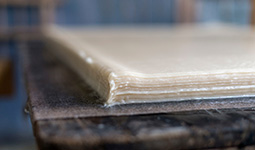Home > Highlighting JAPAN > Highlighting Japan December 2016 > Traditional Crafts
Highlighting JAPAN


Paper Pure as the Driven Snow
When it comes to washi paper making, Honminoshi master craftsman Masashi Sawamura is the “genuine” article.
A rhythmic rattle and swish fills Masashi Sawamura’s wattle and daub workshop as the craftsman’s arms swing a suspended wooden frame back and forth through a viscous cloudy mixture with mechanical precision.
Within minutes a translucent membrane-like film has formed on the surface of the suketa bamboo screen, which Sawamura then deftly removes from the frame and peels back to reveal a glistening sheet of what resembles a wafer-thin slice of tofu.
Once pressed and dried under the sun, however, the fruits of his labor take on a more graphic complexion: paper — though certainly not the plain variety.
Honminoshi is a type of tesuki washi, Japanese paper that is crafted entirely by hand and incorporates raw materials and techniques that have been practiced in and around Mino, Gifu Prefecture for more than a millennia.
Indeed, paper production in the region, which in ancient times was known as Mino no Kuni, is acknowledged in historical documents dating back more than 1,300 years.
“Naturally with such an ancient craft, there have been some modifications over the years, but the essential production process is unchanged,” says Sawamura, 87, as he adds a new batch of gooey pulp mixture to the sukibune wooden vat. “The key ingredients to making fine Honminoshi are still pure water, pure air and a pure heart.”
Another is the pulp, known as nasu kozo, which is made from the inner bark of paper mulberry trees that is soaked, boiled, washed and then beaten with spiked wooden mallets on a rough stone slab before being blended with nebeshi — the roots of the tororo aoi plant, a natural starch that serves as a binding agent.
The long, fine fibers of the kozo provide the unique luster, hue and texture that characterizes Honminoshi, which is mostly used for shoji paper screens on sliding doors and for repairing items of cultural heritage. All shoji in Kyoto State Guest House are made of Honminoshi manufactured by Sawamura.
In that sense, Honminoshi is unique — the tesuki art is itself an important cultural asset, a status conferred on it by the Japanese government in 1969 and by UNESCO in 2014.
Sawamura has been making the paper for seventy-two years, since entering the trade at 15, when he became his family’s fourth-generation tesuki craftsman.
Much has changed in that time. The prevalence of mass-produced papers have shrunk the hand-made paper market almost beyond recognition. Whereas as a teenager his family would produce more than 200–300 sheets of paper a day, today he produces one-tenth that volume.
According to Takeshi Seiyama, director of the Mino-Washi Museum, a century ago there were as many as 3,773 paper craftsmen in Mugi district, which was centered around present-day Mino. This included those craftsmen using fibers from ganpi shrubs, or mitsumata (oriental paperbush), which characterize another paper that is known simply as “Minoshi” that today is largely machine-manufactured.
According to Seiyama, today just eighteen workshops remain, of which five are tesuki workshops producing Honminoshi, sometimes referred to as “Genuine Minoshi” due to its strict adherence to the use of materials and techniques handed down from olden times.
“In addition to this there are ten trainees, a product of a resource development system and an initiative of the Association for the Preservation of Honminoshi,” Seiyama says. “The aim is to ensure the craft continues for thet next generation and the UNESCO listing has stiffened our resolve.”
Sawamura is imparting his expertise to one of those trainees, Yukiyo Terada, who has relocated to Mino from Yokohama.
“Our philosophy has always been, if you are going to make handmade paper then you should make it the best handmade paper in Japan. That remains the same and although each day conditions change – the condition of the raw materials, the weather conditions, your own condition – I’m still determined to make even better paper today than I made yesterday.”
© 2009 Cabinet Office, Government of Japan









